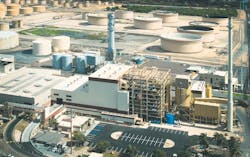Assuring Accuracy in Hawaii
About the author: Jennifer Kerckhoff is vertical market manager for McCrometer. Kerckhoff can be reached at [email protected].
The accurate measurement of cooling tower blowdown water flowing at irregular intervals prior to reinjection into a caprock well became a stubborn problem for Covanta Energy Corp. at the Honolulu H-POWER (Honolulu Program of Waste Energy Recovery) facility on the island of Oahu, Hawaii. The irregular flow intervals created foam and bubbles in the line, which required a new flowmeter solution.
“The FPI Mag flowmeter from McCrometer solved our problem,” said Jeff Vaughn, chief engineer. “I watched the FPI video and showed it to the installer. There was no need to shut down the line or the whole plant for a 10-minute meter job.”
Covanta Honolulu, known as the H-POWER facility, began operation in May 1990 and is owned by the city and county of Honolulu. The facility serves the waste disposal needs of 850,000 residents and 6 million annual visitors. Up to 3,000 tons per day of municipal solid waste is processed, and it generates up to 90 MW of energy—meeting almost 8% of Oahu’s energy needs.
Flowmeter Accuracy
According to Vaughn, the accurate measurement of the cooling tower blowdown water before reinjection into the facility’s caprock well must remain within the 2-million-gal-per-day (mgd) permit held by the facility. “We have to remain within our permit requirement, and our typical water flow rate is slightly less than that amount,” he said.
The accuracy of the flowmeter is important because the plant operator Covanta could face substantial fines if the facility exceeds its daily water permitted use limit. In addition, the H-POWER facility is a green technology waste-to-energy facility where every effort has been made to ensure that processes minimally impact the environment.
The “caprock” type well refers to a geologic structure in which a hard, resistant sedimentary layer of rock overlays weaker rock and traps the aquifer below it. At the H-POWER facility, a caprock well is drilled through this hard rock layer to access the brackish water—non-potable, salinated water—in the underlying aquifer, which serves as the plant’s water supply and reinjection point for its cooling processes.
Cooling towers are utilized in power generation plants to dissipate heat. With makeup water, they convert waste heat into evaporated water in the plant atmosphere, relying on plant air circulation to perform the cooling. The waste blowdown water from the cooling tower operations at the H-POWER Plant then is transported via a 12-in. line for reinjection into the caprock well to eliminate any waste.
The H-POWER facility generates a lot of heat. It utilizes both refuse-derived fuel and mass burn technologies, allowing for comprehensive management of the island’s wastes. These materials are burned to heat boilers, which produce steam for electric power-generating turbines that in turn produce renewable energy for the Hawaiian Electric Co.
The steam is condensed using water from the facility’s circulating water system and is reused in the boiler system. Excess heat is rejected with the help of the facility cooling towers. The caprock wells provide brackish water that is first used for cooling tower makeup water. Other than the cooling tower blowdown water reinjection, the facility has zero liquid discharge.
“We had given up on the old flowmeter and were using other information to estimate the approximate flow,” Vaughn said. “The strap-on ultrasonic meter that was installed in that location continuously cycled from zero to full scale and didn’t match other plant measurements. We had to keep sending a guy down to reset it.”
Aware of the ultrasonic flowmeter problem at H-POWER, Covanta’s headquarters team in Morristown, N.J., began looking for a new meter solution. Covanta’s Robert Margolis, project manager, and Demetri Gounaris, corporate engineering, contacted McCrometer to discuss the situation.
The applications team at McCrometer listened to the problems, including the irregular flow intervals of the cooling tower blowdown water, the foaming bubbles in the 12-in. line, and the location of the meter on a curving underground line with limited access and space. To address these issues, McCrometer recommended its FPI Mag flowmeter.
With no shutdown necessary on the cooling tower blowdown water discharge line to perform the installation, the company was able to avoid impacting the plant’s power-generating capabilities or compromising its environmental standards. The FPI Mag flowmeter’s signal converter features an advanced filtering algorithm to support accuracy of ±0.5% from 1 ft/s to 32 ft/s and of ±1% from 0.3 ft/s to 1 ft/s of reading. Built-in dual 4-20 mA outputs offer communication flexibility, and additional programmable outputs serve to support the facility’s distributed control system.
Both the H-POWER site engineering and the Covanta corporate engineering teams were satisfied with the accuracy of the FPI Mag flowmeter. The measurement problem was solved, allowing the facility to meet its 2-mgd permitted water use limit. The team at Covanta also was pleased with the installation ease and flexibility of the FPI Mag meter, which did not require shutting down the line and potentially impacting the facility’s operations.
Download: Here
